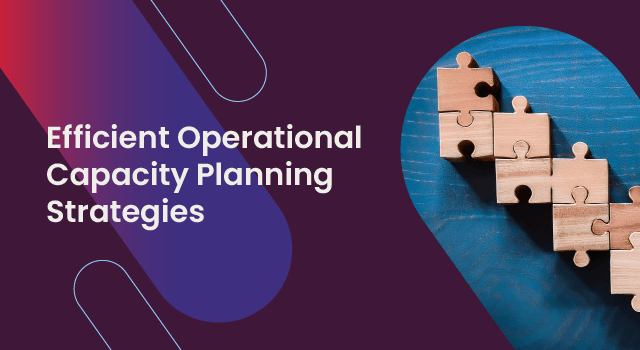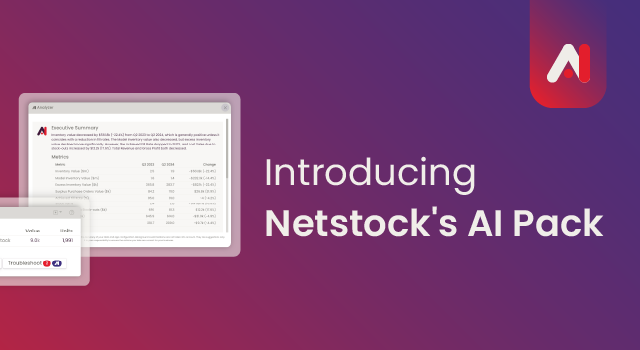Improved supplier data will give your business a competitive advantage and drive customer loyalty.
Netstock recently collaborated with leading supply chain transformation expert, Lisa Anderson, Founder & President of LMA Consulting, to discuss how businesses can improve supply chain processes and reduce supplier risk to ensure they meet demand.
According to Zippia.com, only 6% of companies report having complete supply chain visibility. With access to improved supplier data, you’ll better understand your supplier network and utilize these insights to ensure you make the best decisions to optimize your planning. Investing in a supply chain planning solution that monitors and measures suppliers’ reliability will increase supplier visibility across your supply chain.
Five tips for managing supplier risk:
#1: Understand your supplier network.
Step one: Classify your suppliers. To prioritize your efforts, you should know the following information about your suppliers:
- Which suppliers deliver on time and in full?
- How many items each supplier provides?
- The average lead time per item?
- What items come from which locations?
External disruptions also impact suppliers. By increasing the frequency of communication with your suppliers, you’ll know if they are experiencing any challenges in sourcing materials or potential delays in delivering your products. This information will help your business quickly adapt to any increased lead times so you can find an alternative solution.
Step two: Use a dashboard to disseminate the data. Work with improved real-time supplier data across your supply chain. During these volatile times, having a Sales & Operations Planning solution in place can help manage the data and provide visibility to make the best choices to help your business minimize supplier risk.
Step three: Diversify your suppliers.The COVID-19 pandemic accelerated trends like nearshoring, simplifying the supply chain, and diversifying suppliers. Uncontrollable events will continue, and it’s best practice to source alternative suppliers to support nearshoring efforts.
#2: Measure supplier performance
Identify the risk exposure of each supplier in your supply chain. A replenishment planning tool will analyze your supplier data and review supplier lead times. One of the most common issues supply chains deal with is planned lead times vs. actual lead times. Something as simple as this can make all the difference in serving your customers with high service levels. – Lisa Anderson, Founder & President of LMA Consulting
Work with secondary suppliers. Doing business with your secondary suppliers once in a while, even if you don’t need to, or just to see their process flow, can help you. – Russ Graf, VP of Channel Management at Netstock.
“Sustaining these secondary relationships will benefit you in the long run because you’ll be familiar with these suppliers. The added comfort of understanding your secondary suppliers’ processes will be helpful to your business, and chances are you might receive preferential treatment over a new vendor since there is already an existing relationship. So when you need them, you’ll be ready to go.”
Consolidate your suppliers. Having too many suppliers can mean having less control. There are three approaches to figuring out the best way to prioritize working with your suppliers:
- Strategic importance
- Through the scope of compliance
- Analyzing current and historical supplier data.
Ask yourself:
- Do your suppliers deliver on your agreed terms and conditions?
- Do you know your supplier’s carbon footprints, etc.?
The answers to these questions can be helpful when determining what direction is best for your supply chain.
#3: Mitigate the impact of extended lead times
Mitigating extended lead times is not easy. “I have seen customers doing a variety of things. One of the lessons from the pandemic is that businesses got a little too conservative. There was so much emphasis on being lean with the just-in-time mentality that they got caught short because it was such a tight environment,” continues Russ.
Most businesses didn’t expect the just-in-time inventory planning method to have such outrageous lead times. “Demand planners realized they needed stockpiles in certain locations to accommodate their network and hold more strategic safety stock,” says Russ.
Staying in touch with your supplier throughout production will ensure expectations are met, and issues are addressed promptly. Providing your key performance indicators (KPIs) to your supplier will also help motivate them to achieve the levels of service you expect.
#4. Review your supply chain processes
People, processes, and technology are the three key factors here. If your business has the right people, you still need to provide your team with efficient processes to ensure success. By reviewing supply chain processes, you can adapt your planning as disruptions can occur in the blink of an eye.
Regarding supplier best practices, you should consider how they apply to your business. “It is quite easy to duplicate efforts and data, but you should evaluate best practices and tailor them for your unique needs. Around 80% of client success goes back to that question,” continues Lisa Anderson.
Think about how best practices apply to your business, and the nuances of your people and the environment you are working in play a huge role. Being nimble, making quick adjustments to your supply chain strategies and processes, having the right technologies, and using the appropriate internal and external best practices can make all the difference.
#5. Use the right tools to analyze supplier data
Using the right technology to manage your supply chain can mean many things, depending on your industry. ERPs do a great job collecting and organizing data; however, you’ll still need additional tools like business intelligence, dashboards, and third-party add-on tools that enhance your ERP data, like Netstock.
“You need tools to measure and analyze your supplier data to stay on top of changing conditions, make the appropriate adjustments in your processes and systems, and help you successfully service customers while being profitable and freeing up working capital,” says Lisa. Replenishment planning tools can also help improve employee efficiency and retention. Many people in supply chain management or demand planning roles experience burnout due to the large task of managing inventory manually on legacy systems and working off spreadsheets. Providing your team with the proper tools enables them to work smarter and increases their work satisfaction.
Use these five steps to manage and identify supplier risk across your supply chain. And remember to:
- Review your current suppliers
- Make necessary changes, and
- Implement solid best practices to optimize your inventory planning.




